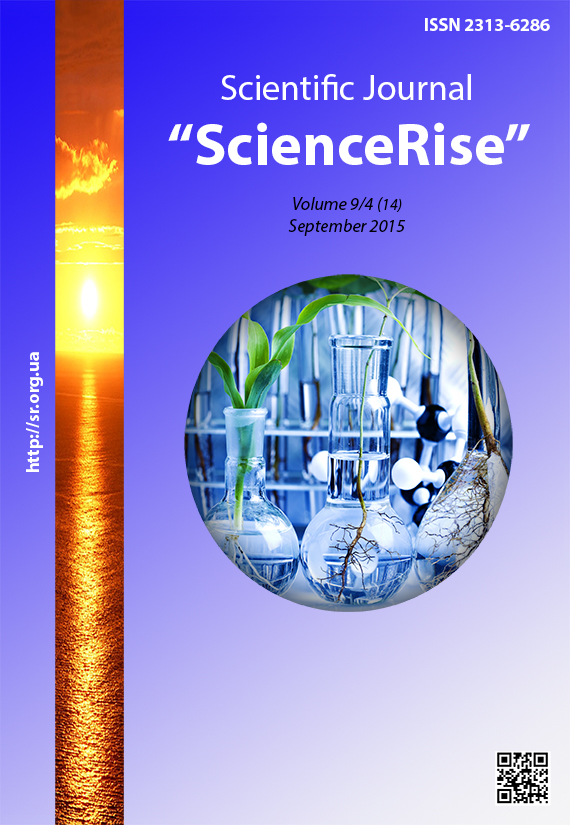Clinical and laboratory peculiarities of cryptococcal meningoencephalitis in patients with hiv-negative status
DOI:
https://doi.org/10.15587/2313-8416.2015.50608Keywords:
cryptococcous, cryptococcal meningoencephalitis, antifungal therapy, intrathecal therapy, cerebrospinal fluid (CSF), immunity, diagnosticsAbstract
Aim of research: to study the clinical, ummunologic, pathomorphologic peculiarities of cryptococcal meningoencephalitis in patients with HIV-negative status.
Materials and methods: there were examined and treated 9 patients (5 women and 5 men 23-65 years old) with cryptococcal meningoencephalitis (CME) with HIV-negative status. In this group of patients in 3 (33,3 %) mycotic injure of nervous system developed on the background of pathology of ENT-organs (2 – larynx cancer, 1 – nasopharynx tumour), in 2 (22,2 %) – endocrinopathy (decompensated diabetes mellitus type 11, chronic suprarenal insufficiency), in 1 case tuberculous meningoencephalitis, chronic suprarenal insufficiency connected with chronic pyelonephritis, polypous cystitis, hemolytic anemia, colloid cyst of the 111 ventricle of brain. Among persons with pathology of ENT-organs three patients entered into intensive care department (ICD) after operative treatment and repeated courses of chemo- and radial therapy, 1 – after palliative operative treatment.
Results: Primary clinical manifestations of cryptococcal menongoencephalitis depended on premorbid background and character of previous medical manipulations. Typical gradual development of CME was noticed only in patients with decompensated somatic pathology. In single cases initial manifestations of CME can flow acutely, violently imitating an image of an acute disorder of brain blood circulation or feebly, inertly on the background of already present neuroinfection. It was set the separate group of patients whose development of CME had a temporal connection with previous operative interventions. Most patients were transferred to IEID (Public Institution “Institute of Epidemiology and infectious diseases L.V. Gromashevsky National Academy of Medical sciences of Ukraine’) at the mean on 18±2,1 day of disease in the grave condition, in all cases the late diagnostics of disease was observed. At admission in 8 cases were microscopically detected microorganisms (yeast cells) that are morphologically similar to cryptococcous including actively budding forms. In CSF of 3 patients (in one case at the negative microscopy) antigens Cryptococcus neoformans was detected by the method of latex-agglutination (CALAS®system).
Conclusions: The risk group on development of cryptococcal meningoencephalitis on the background of HIV-negative status is patients with oncopathology (especially of ENT-organs and brain), chronic somatic pathology at the stage of decompensation, tuberculosis. The negative results of microscopic and culture study of CSF for Cryptococcus neoformans are not the reason for excluding the diagnosis cryptococcal ME at primary examination and in the course of treatment it not always indicate recovery (the end of pathologic process). The combined intensive care with intrathecal methods allow carry out monitoring of intracranial pressure (ICP), CSF, to rise an efficiency of intensive care and the survival rate of patients in first 3-4 months. The lethality at cryptococcosis of CNS is as before the one of the highest and reaches 42,9 %
References
Elinov, N. P., Bosak, I. A. (2006). Proshloe i nastojashhee Cryptococcusneoformans (Sanfelice) Vuillemin (1901) kak ob’ekta izuchenija potencial'no groznogo patogena dlja cheloveka. Problemy med. Mikologii, 8 (2), 47–51.
Bosak, I. A. (2009). Sravnitel'naja harakteristika prirodnyh i klinicheskih izoljatov Criptococcusneoformans. Sankt-Peterburg, 22.
Vasil'eva, N. V. (2005). Faktory patogennosti Cryptococcusneoformans i ih rol' v patogeneze. Sankt-Peterburg, 340.
Filippova, L. V. (2014). Osobennosti immunnogo otveta na shtammy Cryptococcusneoformans raznoj. Sankt-Peterburg, 140.
Kurbatova, I. V. (2000). Vozbuditeli opportunisticheskih gribkovyh infekcij v klinicheskoj praktike. Moscow, 160.
Vengerov, Ju. Ja., Volkova, O. E., Safonova, A. P., Svistunova, T. S., Vorob'ev, A. S., Marinchenko, M. N., Martynova, N. N. (2013). Klinika i diagnostika kriptokokkovogo meningojencefalita u bol'nyh VICh-infekciej. Moscow, 85.
Lesovoj, V. S., Lipnickij, A. V. (2008). Mikozy central'noj nervnoj sistemy (obzor). Problemy med. Mikologii, 10 (1), 3–6.
Bartlett, Dzh., Bartlett, Dzh., Gallant, Dzh., Fam, P. (2010). Klinicheskie aspekty VICh-infekcii 2009–2010. Moscow, 459.
Ignat'eva, S. M., Medvedeva, N. V., Klimko, N. N. (2013). Sluchaj uspeshnogo lechenija kriptokokkovogo meningojencefalita u pacienta s hronicheskim limfocitarnym lejkozom. Problemy med. Mikologii, 4, 31–36.
Klimko, N. N. (2007). Mikozy: diagnostika i lechenie. Ruk-vo dlja vrachej. Moscow, 336.
Charushulina, I. P. (2013). Diagnostika i lechenie kriptokokkovogo meningojencefalita u VICh-inficirovannyh pacientov. Lechenie i profilaktika, 4, 58–61.
Downloads
Published
Issue
Section
License
Copyright (c) 2015 Сергей Петрович Борщев, Елена Леонидовна Панасюк, Дарья Владимировна Говорова, Анатолий Валентинович Филиппенко

This work is licensed under a Creative Commons Attribution 4.0 International License.
Our journal abides by the Creative Commons CC BY copyright rights and permissions for open access journals.
Authors, who are published in this journal, agree to the following conditions:
1. The authors reserve the right to authorship of the work and pass the first publication right of this work to the journal under the terms of a Creative Commons CC BY, which allows others to freely distribute the published research with the obligatory reference to the authors of the original work and the first publication of the work in this journal.
2. The authors have the right to conclude separate supplement agreements that relate to non-exclusive work distribution in the form in which it has been published by the journal (for example, to upload the work to the online storage of the journal or publish it as part of a monograph), provided that the reference to the first publication of the work in this journal is included.

